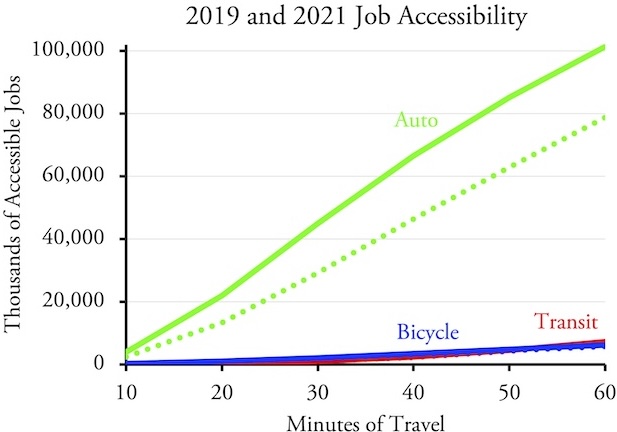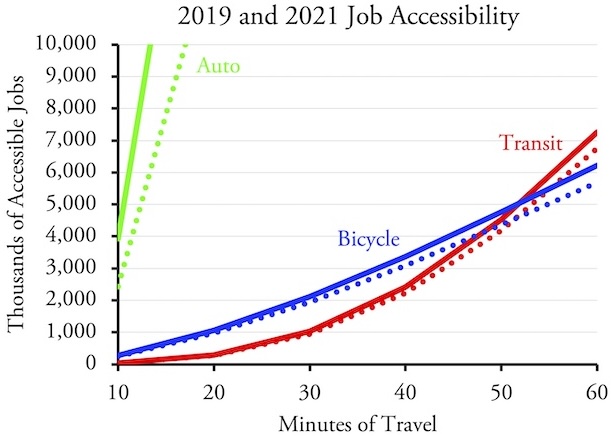Data published by the University of Minnesota Accessibility Observatory a few months ago reveals some of the benefits of congestion relief that resulted from the COVID pandemic. I’ve used 2019 data in the past to show that residents of U.S. urban areas can reach far more jobs in a 20-minute auto drive than a 60-minute transit trip. The latest data for 2021 reveal that the number of jobs reachable by transit or bicycle was about 9 percent greater in 2021 than 2019, but the number reachable by a 20-minute auto drive was 66 percent greater.
On average, over 50 urban areas and for trips of 10 to 60 minutes, auto users were able to reach 48 percent more jobs in 2021 than in 2019. Solid lines show 2021 and dotted lines show 2019.
These numbers are the average of the nation’s 50 largest urban areas, but for some the increased access caused by less traffic was much greater. In a 20-minute auto drive, residents of Atlanta, Boston, Los Angeles, San Francisco, San Jose, and Washington could reach more than twice as many jobs in 2021 than in 2019. Of course, jobs are only one possible set of destinations that became more accessible; other social and economic opportunities also became equally more accessible.
Transit riders were able to reach only 7 percent more jobs and bicycle riders 9 percent more in 2021 than in 2019. Solid lines show 2021 and dotted lines show 2019.
The Texas Transportation Institute documents that congestion in U.S. urban areas dramatically rose between 1982 and 2019. The average number of hours of delay imposed on individual commuters grew by nine times. This growth was because many cities had made a deliberate decision not to try to relieve congestion under the argument that increased capacity simply leads to more driving.
The response to this should have been: So what? Very little driving is frivolous. Instead, most of it is people trying to get to work, school, shopping, health care, friends and relatives, or recreation activities. Then there are trucks moving freight, bringing construction materials and services to work sites, and so forth. Anything that results in more such travel is a good thing because it means more economic activity, more income for people, and more access to better housing, lower-cost consumer goods, and other benefits. The sign of failure is if the new road capacity isn’t used, not if it is.
Many transportation analysts believe that people are willing to spend an average of about an hour a day on the road. That means that they would prefer to spend no more than about 20 minutes driving to work, which means 40 minutes round trip, leaving 20 minutes for other weekday travel. The congestion relief offered by the pandemic vastly increased the economic opportunities available to people within that time constraint.
On the other hand, to the extent that increased congestion was designed to discourage people from driving, that effort failed. Even in New York City, the most transit-friendly and one of the most congested urban areas in the nation, autos could reach far more jobs than transit in 2019, so the disincentive to drive imposed by congestion was small. This is reflected in the fact that urban Americans in both New York and the rest of the country drove more than twice as many miles in 2019 than in 1982 despite the nine-fold increase in congestion during that time.
Since 1992, the earliest year data are available, U.S. transportation agencies spent more than $320 billion ($420 billion in today’s dollars) constructing and reconstructing rail transit
On the other hand, if cities had spent even a quarter of the hundreds of billions of dollars spent on rail transit projects since 1992 on highway improvements instead, the congestion relief those improvements would have provided would have allowed far more economic activity, giving low-income people access to better jobs and everyone access to more affordable housing and other benefits. Like most wars, the war on the automobile has done far more economic harm than the negligible benefits it provided.










62% of Americans support the war on cars (removing parking minimums):
https://www.pewtrusts.org/en/research-and-analysis/articles/2024/01/31/support-for-policies-that-promote-more-housing-crosses-geographic-lines
Removing parking minima is not making war on cars. Putting in parking maxima would be an act of war. I suspect 62% of Americans wouldn’t support being told there is no parking for them at work, the supermarket, or their home.
Automobiles give people the greatest choice about where they live and work since, in theory, they can live anywhere and work anywhere limited only by how long a commute (drive) they will live with.
Public transit limits peoples’ choice of where they live and work. They need to live withing walking distance of a transit stop and work within walking distance of a transit stop.
And the people running public transit can change stops, routes and schedules when ever and how ever they want.
Parking mandates help to prevent developers from externalizing the cost of parking on the public. Getting rid of parking mandates is just giving free parking to large scale developers who can afford urban land prices or building garages, to the detriment of the community.
See Jamaica area of Queens New York whose business now boarded up when side parking was eliminated for bus only lane.
Mission Street San Francisco, now ghost town…..
Behind every car free street…is parking
This actually makes no sense. Depending on where the development is occurring, property values could plummet without sufficient parking necessarily to provide access to said development.
> The response to this should have been: So what?
Yeah, but we all know the wacktavists screaming about “induced demand” are totally nonsensical apocalypse-worshiping nut jobs. In their mind, it’s bad for the environment and climate change – doesn’t matter if your job is driving an electric car to your job as an environmental consultant that trains whales to use their psychic energy to reduce climate change: all driving, for any reason, is literally death.
Hell, these idiots would by ambulances and fire trucks on bikes if they could.
But anyways, you should do this same calculation of available jobs by data packet transportation infrastructure (i.e., internet) – because my commute from my bedroom to desk unlocks 10,000 jobs without any car maintenance!
instead of TOD (if a true concept?) is DOT, development oriented transisit a better course? take the densest part of a city, limit car parking so as to encourage people to move into those dwellings who work near those dwellings, and create transit accordingly in the densest areas? mixed ares , ie areas with cars and less dense get flxible transit for those who might need it and the rest of the money on getting cars to flow more freely as can be managed? im sure the sprawl issue will arise with this plan but i think it has been dealt with here.
“limit car parking so as to encourage people to move into…”
Why do you think in such a way? People have things to do and don’t want to be part of your weird social experiment.
Portland Oregon, subsidized over 7 Billion dollars for lightrail and streetcars and over 3 Billion on Transit oriented development….ALL failed til they
Spent mere 150 million on 5 garages.
10 Billion of your tax dollars on social engineering…… fail.
0.15 Billion on parking…. but it’s an “Economic detriment”
I’m no fan if seas of asphalt…. but meh.
Europe’s grand scale social engineering didn’t work either
Passenger mile Modal split
USA ?? 85% driving
Eu-27. 80%
My the fuqing difference
Interesting article confirming antiplanner’s point concerning the benefits of Covid-related congestion reduction:
“Since the pandemic, traffic has spread out more evenly through the day, and so speeds have increased”
https://web.archive.org/web/20240203134307/https://www.economist.com/united-states/2024/01/18/why-car-insurance-in-america-is-actually-too-cheap
“Since then, the number of severe crashes has climbed. It is hard to say exactly why. New, heavier sports utility vehicles and pick-up trucks seem to be deadlier. Since the pandemic, traffic has spread out more evenly through the day, and so speeds have increased. Insurers also point to more people driving while looking at their phones. Whatever the cause of the spike, in 2022 nearly 43,000 people were killed in car crashes, including 7,500 pedestrians—the highest figure since 1981.”
As pedestrian fatalities increase, this provides an economic incentive for people to stop dangerous activities like walking and bicycling and instead purchase a vehicle, providing them greater safety. Good news all around!
Could be migrants who read English driving our roads.
https://apnews.com/article/migrants-dead-crash-smugglers-texas-honduras-georgia-2eee4b9725a3de7646c83bbea7da9f8c
Or this case can’t. Bidens unrestricted access past our birder puts tens thousands of non English reading rif raf on our streets.
No license
No real ID
NO insurance
No registry
LazyReader, you’ve got a ways to go, but it’s great to see you trying your best to learn English. Keep at it!
Meanwhile Apples new vision Pro is out 3,500 dollars so you can divert your attention at a computer screen that’s partially transparent and still walk distracted
This is the same thing which SaveHywd and HELP vs City of LA said back in 2012 and Judge Goodman accepted in Jan 2014, when said that the city of LA “intentionally used fatally flawed data and wishful thinking to the extent it subverted the law.”
SaveHywd and HELP said that we needed to de-centralize and de-densify in order to make LA more viable. The city ignored the judge and now its Millennials and Gen Zers are leaving